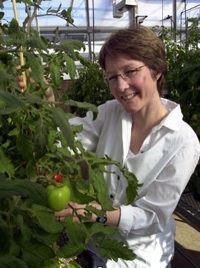
Features
Crops
Vegetables
OSU analyzing fruit shape variations
January 20, 2010 By Mauricio Espinoza OSU
 Jan. 19, 2010 – The Ohio State University and several collaborators have
Jan. 19, 2010 – The Ohio State University and several collaborators have
landed a $3.8 million grant from the National Science Foundation (NSF) to
further innovative research seeking to decipher the molecular mechanisms that
regulate fruit shape.

|
|
|
|
Jan. 19, 2010 – The Ohio State University and several collaborators have
landed a $3.8 million grant from the National Science Foundation (NSF) to
further innovative research seeking to decipher the molecular mechanisms that
regulate fruit shape.
The four-year grant is a joint endeavour between Ohio State’s Ohio
Agricultural Research and Development Centre (OARDC), The Ohio State University
Agricultural Technical Institute (Ohio State ATI), The College of Wooster, and
Boyce Thompson Institute (BTI) on Cornell University’s Ithaca, N.Y., campus.
Other collaborators include natural sciences research institute RIKEN and Chiba
University, both in Japan.
The research project is led by Esther van der Knaap (photo at right), a geneticist in
OARDC’s Department of Horticulture and Crop Science, who utilizes tomato as a
model to analyze fruit shape variations. Her work has received previous NSF
support and has been featured on the cover of the prestigious journal Science (http://researchnews.osu.edu/archive/tomshape.htm).
As part of this investigation, van der Knaap’s lab has cloned a gene
(dubbed SUN) that plays a significant role in the elongated shape of some types
of tomato. The discovery could help unravel the mystery behind the huge
morphological differences among edible fruits and vegetables as well as provide
new insight into mechanisms of plant development. Only two other genes, OVATE and
FASCIATED, are known to control the shape of tomato – a diverse fruit that has
evolved from a very small, round wild ancestor into the wide array of
cultivated varieties known today.
“The focus of this research is to discover genes and networks that regulate
tomato fruit morphology and learn how these genes affect fruit shape,” van der
Knaap said. “The knowledge about fruit morphology genes allows us to
investigate whether the tremendous diversity in tomato fruit shape and size is
controlled by these genes, and how these genes can be employed by breeders in
their efforts to develop new varieties with distinct features.”
This grant will allow researchers to delve more deeply into the function
genes like SUN have in plant development and fruit shape. BTI scientists, for
example, will study the role of auxin, a hormone that regulates many aspects of
plant growth and that also seems to be involved in controlling tomato fruit
shape.
“We expect to gather information about which genes are expressed during
tomato fruit development and how their expression can be restricted to specific
tomato tissues,” said Carmen Catalá, a senior research associate in plant
biology at BTI and one of the grant’s co-principal investigators. “We will then
select a particular set of genes that mediate the action, transport or
synthesis of auxin and study how they can be involved in the control of fruit
growth and shape.”
In addition to biological, biochemical and molecular research, success of
the tomato morphology study also relies on bioinformatics and statistical
modeling – which are crucial for measuring, recording and analyzing changes in
fruit shape and size. The NSF grant will boost development of these areas
through partnerships with Brian McSpadden Gardener, an OARDC plant pathologist;
Tea Meulia, director of OARDC’s Molecular and Cellular Imaging Centre (MCIC);
and mathematics and computer science faculty at The College of Wooster, a
liberal arts school.
Previous collaborations between OARDC and The College of Wooster had led
to the creation of the Tomato Analyzer, a unique software program van der Knaap
now employs to more accurately and automatically measure the effects on fruit
shape and size of different regions of the tomato genome. The new research
dollars will provide continued support of the software. Moreover, Sofia Visa, a
College of Wooster computer science professor and co-principal investigator,
will assist van der Knaap’s lab in better understanding the correlations
between gene expression and morphological data.
Another dimension of the NSF grant is the involvement of undergraduate
and high school students in field and laboratory activities, with the goal of
increasing their knowledge and appreciation of plant science and crop
diversity. Students from both The College of Wooster and Ohio State ATI (a
two-year technical institution) will be engaged in various studies related to
fruit morphology, improvement of the Tomato Analyzer software and training in
bioinformatics skills.
Carri Gerber, an assistant professor at Ohio State ATI, will serve as
outreach coordinator for the grant, facilitating the participation of high
school students in workshops held at Ohio State facilities. Experiments will
also be conducted at high schools with the help of “travelling laboratories”
that will be purchased thanks to the grant.
“This is a reflection of the calibre of our faculty,” said Ohio State ATI
Director Stephen Nameth. “Even though Dr. Gerber’s appointment is 100 per cent
teaching, she and faculty like her can still make a significant contribution to
research proposals.”
Van der Knaap said research findings from the project will be shared with
the scientific community at large via websites such as the Solanaceae Genomics
Network (http://sgn.cornell.edu ),
the Plant MetGenMAP database (http://bioinfo.bti.cornell.edu/cgi-bin/MetGenMAP/home.cgi)
and the Gene Expression Omnibus (http://www.ncbi.nlm.nih.gov/geo).
Beyond contributing to the scientific community’s understanding of plant
development, the tomato shape research endeavor is expected to provide clues of
how the shape and size of produce can be improved to benefit growers,
processors and consumers.
More information about this project can be found at http://www.oardc.ohio-state.edu/vanderknaap.
The research arm of Ohio State’s College of Food, Agricultural, and Environmental
Sciences, OARDC is the largest university agbioscience research centre in the
nation.
Mauricio Espinoza is an OSU communications specialist.
Print this page